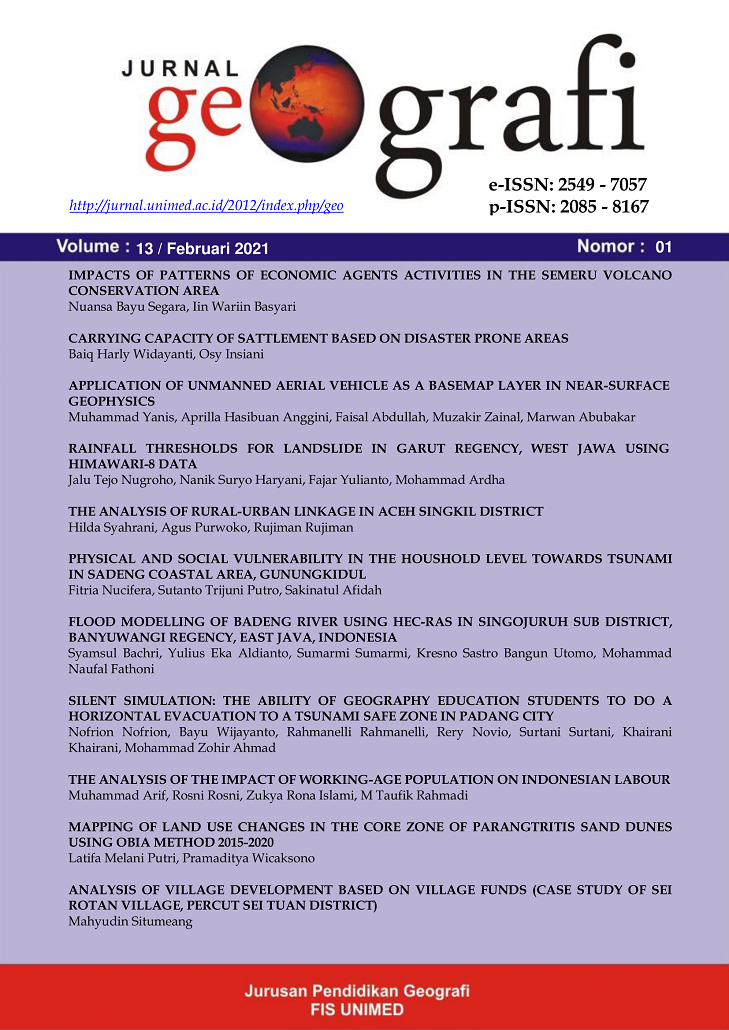IMPACTS OF PATTERNS OF ECONOMIC AGENTS ACTIVITIES IN THE SEMERU VOLCANO CONSERVATION AREA
DOI:
https://doi.org/10.24114/jg.v13i1.16540Abstract
Semeru volcano is the most popular mount hiking tourism in Indonesia. The economic community and conservation area are affected by these activities. This research focuses on the development activities of economic agents pattern and explains the impact of high tourism in the Semeru Volcano conservation area. It was a qualitative study, and the participative observatory was a procedure for collecting the data. The location was not limited in the Semeru Volcano, but also social media, Instagram. The result of the research reveals that there are two kinds of economic agents, namely internal and external. They have positive connectedness to support hiking activities. Although there should be potential for competition between open trip services and local guides, this does not happens, due to the wisdom of internal economic actors, especially local guides. Moreover, the consequences of high tourism activities in the Semeru Volcano conservation area are waste and erosion. The article is concluded by proposing several directions for economic agents to be involved more in conservation activities and positive business in the Semeru Volcano.Key words: Semeru Volcano, economic agent, conservation area, mount tourismGunungapi Semeru merupakan wisata pendakian gunung yang paling populer di Indonesia. Aktivitas ini tentu berdampak terhadap perekonomian penduduk sekitar dan lingkungan di kawasan konservasi. Artikel ini mengkaji pola aktivitas dan pelaku ekonomi yang terlibat dalam perkembangan wisata, dan mengungkap dampak tingginya aktivitas ini terhadap Kawasan Konservasi Gunungapi Semeru itu sendiri. Penelitian ini menggunakan pendekatan kualitatif yang bersifat ekploratif. Pengumpulan data dilakukan secara observasi partisipatif dan tidak terbatas di kawasan pendakian, namun juga melakukan observasi di media sosial instagram. Hasil penelitian menujukan pelaku ekonomi terdiri dari internal dan eksternal kawasan, yang memiliki keterkaitan positif antar pelaku ekonomi dari luar dan dalam Kawasan Pendakian. Meskipun semestinya ada potensi persaingan antara jasa open trip dengan pemandu lokal, akan tetapi hal itu tidak terjadi, karena kearifan pelaku ekonomi internal, khususnya para pemandu lokal. Dampak tingginya aktivitas wisata pendakian ini mengakibatkan dua permasalahan yang cukup serius, yaitu sampah dan erosi. Artikel ini diakhiri dengan memberikan beberapa usulan terkait dengan peningkatan keterlibatan pelaku ekonomi dalam melakukan usaha dan aktivitas konservasi di Kawasan Gunung Semeru. Kata kunci: Gunungapi Semeru, pelaku ekonomi, kawasan konservasi, wisata gunungReferences
Atriyantika, M., Arief, H., & Sunarminto, T. (2014). Studi Konservasi Sumberdaya Alam Hayati Pada Masyarakat Tengger Di Resort Ranu Pani, Taman Nasional Bromo Tengger Semeru. Media Konservasi, 19(1), 1“11. https://doi.org/10.29244/medkon.19.1.
Beedie, P., & Hudson, S. (2003). Emergence of mountain-based adventure tourism. Annals of Tourism Research, 30(3), 625“643. https://doi.org/10.1016/S0160-7383(03)00043-4
Bourdeau, P., Corneloup, J., & Mao, P. (2002). Adventure sports and tourism in the French mountains: Dynamics of change and challenges for sustainable development. Current Issues in Tourism, 5(1), 22“32. https://doi.org/10.1080/13683500208667905
Dowling, R. K. (2014). Global Geotourism “ An Emerging Form of Sustainable Tourism. Czech Journal of Tourism, 2(2), 59“79. https://doi.org/10.2478/cjot-2013-0004
Erfurt-Cooper, P. (2011). Geotourism in volcanic and geothermal environments: Playing with fire? Geoheritage, 3(3), 187“193. https://doi.org/10.1007/s12371-010-0025-6
Erfurt-Cooper, P., Sigurdsson, H., & Lopes, R. M. C. (2015). Volcanoes and Tourism. In The Encyclopedia of Volcanoes (Second Edi). Elsevier Inc. https://doi.org/10.1016/b978-0-12-385938-9.00075-4
Gulpınar Akbulut. (2014). Volcano Tourism in Turkey. In Volcanic Tourist Destinations, Geoheritage, Geoparks and Geotourism (pp. 89“102). https://doi.org/10.1007/978-3-642-16191-9
Hakim, A. R. (2017). Analisis Energi Gempa Letusan Gunung Semeru 09 Oktober 2009. Jurnal Pendidikan MIPA, 7(1), 30“35.
Harjadi, B. (2008). Perhitungan Tingkat Erosi Kualitatif Di Taman Nasional Bromo Tengger Semeru. Seminar Nasional Geomatika 2017: Inovasi Teknologi Penyediaan Informasi Eospasial Untuk Pembangunan Berkelanjutan Erosi, 291“298.
Heggie, T. W. (2010). Geotourism and public safety in volcanic environments. In Volcano and Geothermal Tourism: Sustainable Geo-Resources for Leisure and Recreation. https://doi.org/10.4324/9781849775182
Nepal, S. K. (2002). Mountain Ecotourism and Sustainable Development. Mountain Research and Development, 22(2), 104“109. https://doi.org/10.1659/0276-4741(2002)022[0104:measd]2.0.co;2
Nepal, S. K., & Chipeniuk, R. (2005). Mountain tourism: Toward a conceptual framework. Tourism Geographies, 7(3), 313“333. https://doi.org/10.1080/14616680500164849
Sagala, S., Rosyidie, A., Pratama, A., Wimbardana, R., & Wijayanti, A. (2012). Promoting Volcano Tourism in Hazard Zone Area for Rebuilding Local Economy: Case study of Tourism in Cangkringan Sub-District, Mt. Merapi, Yogyakarta. International Conference on Sustainable Built Environment, Yogyakarta., 1“13. http://www.pl.itb.ac.id/dosen/sas/wp-content/uploads/2015/07/Sagala-Promoting-Volcano-Tourism-in-Hazard-Zone-Area-for-Rebuilding-Local-Economy.pdf
Setiawan, Y. N., & Baiquni, M. (2015). Penilaian Wisatawan Terhadap Kualitas Obyek Wisata Gunungapi Semeru. JBI, 4(1), 178“187.
SI-USGS. (2009). Global Volcanism Program. Http://Www.Volcano.Si.Edu/Reports/Usgs/. http://www.volcano.si.edu/reports/usgs/
Silva, C., Kastenholz, E., & Abrantes, J. L. (2013). Place-attachment , destination image and impacts of tourism in mountain destinations. An International Journal of Tourism and Hospitality Research, 24(1), 17“29. https://doi.org/10.1080/13032917.2012.762312
Sugiharto, S., Delita, F., & Sidauruk, T. (2018). Tingkat Kesiapan Masyarakat Lokal Terhadap Pengembangan Community Based Tourism (CBT) di Kabupaten Samosir. Jurnal Geografi, 10(2), 157. https://doi.org/10.24114/jg.v10i2.10419
Syahadat, E. (2003). The Factors Witch Are Influences To A Tourism Visitor In Gede Pangrango National Park (Gpnp). Jurnal Penelitian Sosial Dan Ekonomi Kehutanan, 3(1), 1“14.
Trauer, B. (2006). Conceptualizing special interest tourism ” frameworks for analysis. Tourism Management, 27(2006), 183“200. https://doi.org/10.1016/j.tourman.2004.10.004
Umar, M. . (2018). Potensi Ekowisata Bahari Pada Pulau-Pulau Kecil Di Halmahera Selatan. Jurnal Geografi, 10(2), 117“128.
Utami, H. S. (2017). Pengelolaan Kawasan Pariwisata (Studi di Balai Besar Taman Nasional Bromo Tengger Semeru) Hadi. Jurnal Ilmiah Administrasi Publik ( JIAP ), 3(1), 13“20.
Yeo, P. F. (2016). A Re-Definition of Verbena brasiliensis. Springer on Behalf of Royal Botanic Gardens, Kew, 45(1), 101“120.







